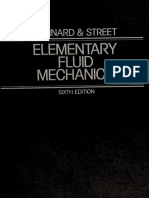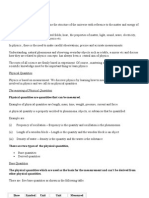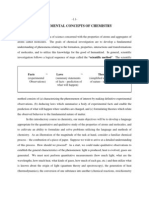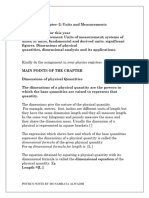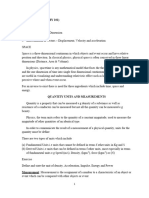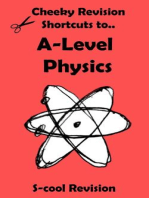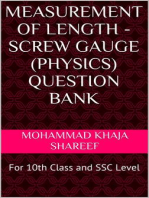Physical Quantities and Units
Physical Quantities and Units
Uploaded by
geok_abeeCopyright:
Available Formats
Physical Quantities and Units
Physical Quantities and Units
Uploaded by
geok_abeeOriginal Description:
Original Title
Copyright
Available Formats
Share this document
Did you find this document useful?
Is this content inappropriate?
Copyright:
Available Formats
Physical Quantities and Units
Physical Quantities and Units
Uploaded by
geok_abeeCopyright:
Available Formats
CHAPTER 1
PHYSICAL QUANTITIES AND UNITS
1
2
Physical Quantities & SI Units
Physics is the study of how the universe/world behaves and
how the laws of nature operate
Physics is a mathematical science. The underlying concepts and
principles have a mathematical basis.
3
Physical Quantities
Physics involves the study of physical quantities and its measurement
Accurate measurement is very important in science particularly physics,
known as the scientific method
Scientific method: observe, measure, collect data & analyse to discover a
pattern to make it a theory, and then law otherwise repeat or reject
A physical quantity is a quantity that can be measured e.g. length, mass or
time of fall
Physical quantities have a numerical value and unit but not always
Some quantities have no units e.g. pi, ratios, radian, strain
A physical quantity can be divided into base quantities and derived
quantities
4
Base Quantities
Base quantities are the quantities that are conventionally accepted as
functionally independent of one another.
It is a quantity that cannot be defined in terms of other physical quantities
nor is it derived from other units, i.e. it is independent of other units.
5
Common language of measurement units
Same as spoken languages, different systems of measurement evolved
throughout the world
Examples: foot, furlongs, cubit, gantang, pounds, carats, grains, kati etc
Foot is the length of King Henry VIIs foot
Although units of measurement can be converted between systems it is
cumbersome and far better to have just one system
Hence the System International (SI) system was born in 1960
6
7 base quantities
The Systme International (SI) is based on 7 fundamental or base quantities
and its units are given below:
Quantity Name of unit Unit symbol
Length metre m
Mass kilogram kg
Time second s
Electric current Ampere A
Temperature Kelvin K
Amount of substance mole mol
Luminous intensity candela cd
7
Beware !
A distance of thirty metres should be written as 30 m and not 30 ms or 30
m s
The letter s is never included in a unit for the plural
If a space is left between 2 letters, the letters denote different units
So, 30 m s would mean thirty metre seconds and 30 ms would mean 30
milliseconds
8
Derived quantities and derived units
A derived quantity is a physics quantity that consists of some combination of base
units
It is a quantity which is derived from the base quantities and is a combination of base
units through multiplying and/or dividing them, but never added or subtracted
All derived units are expressible as products or quotients of the base units
e.g N kg m s
-2
and J kg m
2
s
-2
.
SI derived units are units of measurement defined in the International System of
Units (SI).
They are derived from the seven base units and can be expressed in base-unit
equivalents
Most derived units have a special name
The names of all SI units are written in lowercase. The unit symbols of units named
after persons are always spelled with an initial capital letter (e.g., hertz, Hz; but
meter, m).
The exception is degrees Celsius, which refers to degrees on the Celsius temperature
scale.
9
Derived quantity & equations
A derived quantity has a defining equation which defines the quantity in
terms of other quantities.
It enables us to express a derived unit in terms of base-unit equivalent.
Example: F = ma ; Newton = kg m s
-2
P = F/A ; Pascal = kg m s
-2
/m
2
= kg m
-1
s
-2
10
Some derived units
Derived quantity Base equivalent units _______ Symbol
area square meter m
volume cubic meter m
speed, velocity meter per second m/s or m s
-1
acceleration meter per second squared m/s/s or m s
-2
density kilogram per cubic meter kg m
-3
amount concentration mole per cubic meter mol m
-3
force kg m s
-2
Newton
work/energy kg m
2
s
-2
Joule
power kg m
2
s
-3
Watt
pressure kg m
-1
s
-2
Pascal
frequency s
-1
Hertz
11
Magnitude/size
Magnitudes of physical quantities range from very very large to very very small.
E.g. mass of sun is 10
30
kg and mass of electron is 10
-31
kg.
Hence, prefixes are used to describe these magnitudes.
Common prefixes
12
13
Order of magnitude in metres
Earth to universe 1.4 x 10
26
Earth to Sun 1.5 x 10
11
Length of car 4
Diameter of hair 5 x 10
-4
Diameter of an atom 3 x 10
-10
Diameter of a nucleus 6 x 10
-15
14
Scientific notation
Large and small values are usually expressed in scientific notation i.e. as a
simple number multiplied by a power of ten
A value expressed in the A x 10
n
form where 1 s A < 10 is called the
standard form scientific notation.
There is far less chance of making a mistake with the number of zeroes
E.g 154 000 000 would be written as 1.54 x 10
8
0.00034 would be written as 3.4 x 10
-4
15
Conversions
Since there are so many base units and derived units, and orders of
magnitudes, conversions from one unit to another is inevitable
Let us try some conversions;
a) 30 mm
2
= ? m
2
b) 865 km h
-1
= ? m s
-1
c) 300 g cm
-3
= ? kg m
-3
16
a) 30 mm
2
= ? m
2
( ) ( )
2
3
2
m 10 mm 1
=
2 6 2
m 10 mm 1
=
2 5 2 6 2
m 10 3.0 or m 10 30 mm 30
=
17
b) 865 km h
-1
= ? m s
-1
1 1
s m 240 h km 865
=
18
c) 300 g cm
-3
= ? kg m
-3
-3 5 3
m kg 10 3.0 cm g 300 =
1.2 Dimensions of Pyhsical Quantities
19
20
Dimension Of Physical Quantities
The dimensions of a physical quantity shows the relation between that
quantity to the base quantities
e.g the dimensions of area are Length x Length hence area is the
product of Length.
The dimensions of a physical quantity are a combination of the physical
quantities, raised to the appropriate powers, which are used to define the
physical quantity.
Dimensions are not units.
e.g. dimension of length is L, mass is M, time is T etc
Dimensional analysis is used
to determine the unit of the physical quantity.
to determine whether a physical equation is correct or not
dimensionally by using the principle of homogeneity.
but not if a formula is valid or not
21
Dimension Symbol
Mass M
Length L
Time T
Electric current I
Temperature
Amount of substance N
22
23
Equations
For any equation to make sense, each term involved in the equation must have the
same base units
Look at this equation: 3 kg + 6 kg = 9 m
The numbers are correct but the units make it nonsense
A term in an equation is a group of numbers and symbols, and each of the terms is
added to, or subtracted from other terms
In any equation where each term has the same base units, the equation is said to be
homogeneous or balanced
An equation is homogeneous if quantities on BOTH sides of the equation have the
same unit.
e.g. s = ut + at
2
LHS : unit of s = m
RHS : unit of ut = m s
-1
x s = m
unit of at
2
= m s
-2
x s
2
= m
Unit on LHS = unit on RHS, hence equation is homogeneous
A homogeneous equation may not be physically correct but a physically correct
equation is definitely homogeneous
e.g. a) s = 2ut + at
2
is homogeneous but not physically correct
(correct equation is s = ut + at),
b) F = ma is homogeneous and physically correct (try it!)
24
a) To confirm if equation is homogeneous
E.g: The period of oscillation of a simple pendulum is dependent on the
length l and acceleration of free fall, g.
Is the equation;
T = 2t (l/g) or T = 2t (g/l) ?
Take the first equation T = 2t (l/g)
LHS : unit of T = s
RHS : unit of 2t (l/g) = [ m/(m s
-2
) ]
= s
Equation is homogeneous since unit on LHS = RHS
25
b) To find units of constant
E.g: Newtons Universal Law of gravitation, says that the gravitational
force between two objects is given by the formula
F = GMm/r
2
where F - force,
G - Universal Gravitational constant,
M, m - masses of objects,
r - distance apart.
Find the units of G.
Solution
To find units of G : Rearrange the equation.
G = Fr
2
/Mm
therefore unit of G = N m
2
kg
-2
26
Determining the dimension and unit
Determine the dimension and the S.I. unit for the following quantities:
a. Velocity
b. Acceleration
c. Momentum
d. Pressure
e. Force
27
Example solution for velocity
..... dimension
Hence the S.I. unit of velocity is m s
-1
.
| |
| |
| | interval time
nt displaceme in change
Velocity =
| |
| |
| | t
s
v
A
A
= | |
1
LT
T
L
= = v
28
Exercises
1. The moment of inersia, I, of a uniform rod of mass m and length l about an
axis perpendicular to one end of the rod is given by I=1/3 ml. Find
(a) the units of I and
(b) the dimensions of I
2. Under uniform acceleration, motion of an object with velocity, v, is
represented by v = a + bx where a and b are constants and x is a variable
for displacement. If both a and b have dimensions, find the dimensions of
(a) a
(b) bx
(c) b
3. In a simple pendulum experiment, a student makes an assumption that the
period of oscillation of the pendulum, T, is related to the mass, m, of the
pendulum bob, the length, l, of the string and also the acceleration due to
gravity, g. Derive an equation for T by dimensional analysis.
1.3 Scalars and Vectors
29
A scalar quantity is a quantity that has magnitude only and has
no direction in space
Scalars
Examples of Scalar Quantities:
Length
Area
Volume
Time
Mass
A vector quantity is a quantity that has both magnitude and a
direction in space
Vectors
Examples of Vector Quantities:
Displacement
Velocity
Acceleration
Force
Vector diagrams are shown
using an arrow
The length of the arrow
represents its magnitude
The direction of the arrow
shows its direction
Vector Diagrams
VECTOR APPLICATION
ADDITION: When two (2) vectors point in the SAME direction,
simply add them together.
EXAMPLE: A man walks 46.5 m east, then another 20 m east.
Calculate his displacement relative to where he started.
66.5 m, E
MAGNITUDE relates to the
size of the arrow and
DIRECTION relates to the
way the arrow is drawn
46.5 m, E
+
20 m, E
VECTOR APPLICATION
SUBTRACTION: When two (2) vectors point in the OPPOSITE
direction, simply subtract them.
EXAMPLE: A man walks 46.5 m east, then another 20 m west.
Calculate his displacement relative to where he started.
26.5 m, E
46.5 m, E
-
20 m, W
Vectors in opposite directions:
6 m s
-1
10 m s
-1
= 4 m s
-1
6 N 10 N = 4 N
Resultant of Two Vectors
Vectors in the same direction:
6 N 4 N = 10 N
6 m
= 10 m
4 m
The resultant is the sum or the combined effect of
two vector quantities
The Parallelogram Law
When two vectors are joined
tail to tail
Complete the parallelogram
The resultant is found by
drawing the diagonal
When two vectors are joined
head to tail
Draw the resultant vector by
completing the triangle
When resolving a vector into components we
are doing the opposite to finding the resultant
We usually resolve a vector into components
that are perpendicular to each other
Resolving a Vector Into Perpendicular
Components
y
x
Here a vector v is resolved into
an x component and a y
component
If a vector of magnitude v and makes an angle with the
horizontal then the magnitude of the components are:
x = v Cos
y = v Sin
Calculating the Magnitude of the Perpendicular
Components
y=v Sin
x=v Cos
y
Proof:
v
x
Cos = u
u vCos x =
v
y
Sin = u
u vSin y =
x
NON-COLLINEAR VECTORS
When two (2) vectors are PERPENDICULAR to each other,
you must use the PYTHAGOREAN THEOREM
Example: A man travels 120 km east
then 160 km north. Calculate his
resultant displacement.
120 km, E
160 km, N
the hypotenuse is
called the RESULTANT
HORIZONTAL COMPONENT
VERTICAL
COMPONENT
S
T
A
R
T
FINISH
c
2
= a
2
+ b
2
c = a
2
+ b
2
c = resul tant = 120
( )
2
+ 160
( )
2
| |
c = 200km
WHAT ABOUT DIRECTION?
In the example, DISPLACEMENT asked for and since it is a
VECTOR quantity, we need to report its direction.
N
S
E
W
N of E
E of N
S of W
W of S
N of W
W of N
S of E
E of S
NOTE: When drawing a right
triangle that conveys some type
of motion, you MUST draw your
components HEAD TO TOE.
N of E
NEED A VALUE ANGLE!
Just putting N of E is not good enough (how far north of
east ?). We need to find a numeric value for the direction.
N of E
160 km, N
120 km, E
To find the value of
the angle we use a
Trig function called
TANGENT.
Tanu =
opposite side
adjacent side
=
160
120
=1.333
u = Tan
1
(1.333) = 53.1
o
u
200 km
So the COMPLETE final answer is :
200 km, 53.1 degrees North of East
What are your missing
components?
Suppose a person walked 65 m, 25 degrees East of North. What were
his horizontal and vertical components?
65 m
25
H.C. = ?
V.C = ?
The goal: ALWAYS MAKE A
RIGHT TRIANGLE!
To solve for components, we
often use the trig functions
sine and cosine.
E m C H opp
N m C V adj
hyp opp hyp adj
hypotenuse
side opposite
hypotenuse
side adjacent
, 47 . 27 25 sin 65 . .
, 91 . 58 25 cos 65 . .
sin cos
sine cosine
= = =
= = =
= =
= =
u u
u u
Example
A boat moves with a velocity of 15 m/s, N in a river which flows
with a velocity of 8.0 m/s, west. Calculate the boat's resultant
velocity with respect to due north.
15 m/s, N
8.0 m/s, W
R
v
u
1 . 28 ) 5333 . 0 (
5333 . 0
15
8
/ 17 15 8
1
2 2
= =
= =
= + =
Tan
Tan
s m R
v
u
u
The Final Answer :
17 m/s, @ 28.1 degrees West of North
Scalar product of two coplanar vectors
Scalar product or dot
product of two coplanar
vector a and b is written as
A.B (read as A dot B)
The product is a scalar given
by
where is the angle
between the two vectors.
A.B=B.A
44
B
A
The work done by a force F
when the displacement of its
point of application s is
given by the scalar product
of F and s.
45
Cross Product of Two Coplanar Vectors
46
Resolving Vector
47
Example
48
49
You might also like
- Elementary Fluid Mechanics - Vennard, John K. (John King)Document712 pagesElementary Fluid Mechanics - Vennard, John K. (John King)Aref Malkawi89% (9)
- 1.1 - 1.3introduction To Physics & The QuantityDocument7 pages1.1 - 1.3introduction To Physics & The QuantityayepingpongNo ratings yet
- Gas BillingDocument39 pagesGas Billingrony9992002No ratings yet
- Ch1 - Physical Quantities and MeasurementDocument25 pagesCh1 - Physical Quantities and MeasurementAboudh AboudhNo ratings yet
- Phy 101 Note 22-23Document8 pagesPhy 101 Note 22-23Aye OyemamiNo ratings yet
- ch1 Physics MeasurementDocument20 pagesch1 Physics MeasurementEnow BriceNo ratings yet
- Lecture Notes On PHY 101Document7 pagesLecture Notes On PHY 101Ezenwaka Eucharia100% (3)
- SF017 CH 1 Physical QuantitiesDocument88 pagesSF017 CH 1 Physical QuantitiessureinrajahNo ratings yet
- Chapter 1.1Document20 pagesChapter 1.1geok_abeeNo ratings yet
- Physics - VectorsDocument72 pagesPhysics - VectorsGerardo L. Lo100% (1)
- Unit and Measurements PDFDocument11 pagesUnit and Measurements PDFNihaal SharmaNo ratings yet
- Physical Measurement1Document13 pagesPhysical Measurement1Gaber HassanNo ratings yet
- Introduction To Physics and MeasurementDocument9 pagesIntroduction To Physics and MeasurementNishant CortezNo ratings yet
- Mechanics Physics 1Document44 pagesMechanics Physics 1fordjourwilfred65No ratings yet
- 01units and DimensionsDocument14 pages01units and DimensionsSumathi SrinivasNo ratings yet
- 1 - Physical Quantities & Units PDFDocument53 pages1 - Physical Quantities & Units PDFNkengafac Armstrong menjuaNo ratings yet
- 1 - Physical Quantities & Units PDFDocument53 pages1 - Physical Quantities & Units PDFMazinNo ratings yet
- 2 - Physical Quantities and Measurements1 - Physical Quantities & UnitsDocument27 pages2 - Physical Quantities and Measurements1 - Physical Quantities & UnitsCHARLES CHIMZNo ratings yet
- Ch. 2Document6 pagesCh. 2Sandy ShohdyNo ratings yet
- Units and MeasurementsDocument20 pagesUnits and MeasurementsVinayak MalhotraNo ratings yet
- Rahadian N - Mechanics - Measurements Units DimensionDocument20 pagesRahadian N - Mechanics - Measurements Units DimensionkhenoskaaNo ratings yet
- ChemistryDocument30 pagesChemistryAravindNo ratings yet
- Units and DimensionsDocument15 pagesUnits and DimensionspokhralikanchhaNo ratings yet
- PHYS 291 Chapter 1: 1. What Is Physics? 2. What Do We Want From This Class? 3. Brief History of Physics 4. Chapter OneDocument18 pagesPHYS 291 Chapter 1: 1. What Is Physics? 2. What Do We Want From This Class? 3. Brief History of Physics 4. Chapter OneRyan LanceNo ratings yet
- PHYS 291 Chapter 1: 1. What Is Physics? 2. What Do We Want From This Class? 3. Brief History of Physics 4. Chapter OneDocument18 pagesPHYS 291 Chapter 1: 1. What Is Physics? 2. What Do We Want From This Class? 3. Brief History of Physics 4. Chapter OneRyan LanceNo ratings yet
- Chapter 1 Physical Quantities and UnitsDocument18 pagesChapter 1 Physical Quantities and UnitsJustice WongNo ratings yet
- Ed02 G10 Phys Ch01 AllDocument20 pagesEd02 G10 Phys Ch01 AllKhin Thant Sin ThwayNo ratings yet
- Chapter 1 GC Phy110Document30 pagesChapter 1 GC Phy110RikachuNo ratings yet
- BS141 Physics PhysicsDocument36 pagesBS141 Physics PhysicsBut Nobody CameNo ratings yet
- Recipe For PHY 107Document37 pagesRecipe For PHY 107Midhun K ThankachanNo ratings yet
- Ch. 1 Measurements and ExperimentationDocument39 pagesCh. 1 Measurements and ExperimentationGrishab SundaraniNo ratings yet
- Lecture Notes 1 - Introduction, Physical QuantitiesDocument4 pagesLecture Notes 1 - Introduction, Physical QuantitiesJezManuel04No ratings yet
- Physical Quantities and Units PDFDocument6 pagesPhysical Quantities and Units PDFprimalNo ratings yet
- Physical Quantities and UnitsDocument6 pagesPhysical Quantities and UnitsprimalNo ratings yet
- Standard112 Volume 1Document20 pagesStandard112 Volume 1Thevakaran ArunasalamNo ratings yet
- Physical Quantities and SI UnitsDocument98 pagesPhysical Quantities and SI UnitsCHICKENLORDMEZNo ratings yet
- Chapter A PHYSDocument4 pagesChapter A PHYSTerra DrakeNo ratings yet
- Unit 1Document7 pagesUnit 101.Adwaith IyerNo ratings yet
- Chapter 1 2018 Kreane 1992 1measurmeantsDocument23 pagesChapter 1 2018 Kreane 1992 1measurmeantsAnoar BarkNo ratings yet
- Class Xi MaterialDocument316 pagesClass Xi MaterialShlok MishraNo ratings yet
- MEKANIKDocument20 pagesMEKANIKBarus TMNo ratings yet
- Physical Quantities Handout.........Document5 pagesPhysical Quantities Handout.........sreekanthreddy peramNo ratings yet
- Introduction To Measurement, Standard and UnitDocument39 pagesIntroduction To Measurement, Standard and UnitIlyia SyafiraNo ratings yet
- Units & Measurements - Chapter 1 Grade 11 CbseDocument28 pagesUnits & Measurements - Chapter 1 Grade 11 CbseZianNo ratings yet
- Units and Measurements PDFDocument25 pagesUnits and Measurements PDFVirendra Gaur100% (1)
- Lesson 1 in Gen Phy1Document16 pagesLesson 1 in Gen Phy1Leanjay FranciscoNo ratings yet
- MeasurementsDocument8 pagesMeasurementsSifatNo ratings yet
- Besaran, Satuan, Dan Pengukuran Dalam FisikaDocument4 pagesBesaran, Satuan, Dan Pengukuran Dalam FisikaRhasyah R. SanjayaNo ratings yet
- Introduction To Petroleum EngineeringDocument32 pagesIntroduction To Petroleum Engineeringboris yeltinNo ratings yet
- Measurement Whole ChapterDocument22 pagesMeasurement Whole Chaptersamridhikohli21No ratings yet
- PhysicsDocument12 pagesPhysicseka123No ratings yet
- Physics FormulaDocument13 pagesPhysics FormulaĞáūřâv ŚïñğhNo ratings yet
- Ipe JR PhysicsDocument144 pagesIpe JR PhysicsSai Varun KruthiventiNo ratings yet
- Synopsis:: Quantities UnitsDocument17 pagesSynopsis:: Quantities UnitsWillSmithNo ratings yet
- General Physics (Phy 101)Document6 pagesGeneral Physics (Phy 101)Adewale Peter OlowatosinNo ratings yet
- A-level Physics Revision: Cheeky Revision ShortcutsFrom EverandA-level Physics Revision: Cheeky Revision ShortcutsRating: 3 out of 5 stars3/5 (10)
- Barron's Physics Practice Plus: 400+ Online Questions and Quick Study ReviewFrom EverandBarron's Physics Practice Plus: 400+ Online Questions and Quick Study ReviewNo ratings yet
- Measurement of Length - Screw Gauge (Physics) Question BankFrom EverandMeasurement of Length - Screw Gauge (Physics) Question BankNo ratings yet
- 2nd Dispatch DLPD - IIT JEE - Class XI - English - PC (Maths) PDFDocument126 pages2nd Dispatch DLPD - IIT JEE - Class XI - English - PC (Maths) PDFPraveen Kumar100% (1)
- Brownlie EcuaciónDocument32 pagesBrownlie EcuaciónJairo MejíaNo ratings yet
- Pace Final Lap 1 PhysicsDocument301 pagesPace Final Lap 1 PhysicsBhavesh KriplaniNo ratings yet
- Chapter 1: INTRODUCTION and Basic Concepts: Fundamental Sciences DepartmentDocument53 pagesChapter 1: INTRODUCTION and Basic Concepts: Fundamental Sciences DepartmentQuang AnhNo ratings yet
- Notes 1.1 - Dimensional Analysis-ConversionDocument11 pagesNotes 1.1 - Dimensional Analysis-ConversionBilly JenkinsNo ratings yet
- Thermodynamics I PDFDocument113 pagesThermodynamics I PDFdaniceNo ratings yet
- Chapter 1 MedDocument43 pagesChapter 1 MedShehzad AhmedNo ratings yet
- Generalizing The Algebra of Physical Quantities: Mark F. SharlowDocument24 pagesGeneralizing The Algebra of Physical Quantities: Mark F. Sharlowalin444444No ratings yet
- Circular Measures PDFDocument11 pagesCircular Measures PDFpizamNo ratings yet
- Skull Crusher-1 Class XI JEE (Adv) PhysicsDocument3 pagesSkull Crusher-1 Class XI JEE (Adv) Physicsuttkarshp72No ratings yet
- Basic Mechanical EngineeringDocument54 pagesBasic Mechanical EngineeringKhushank MNo ratings yet
- Physics: Principles ofDocument20 pagesPhysics: Principles ofNishan SunarNo ratings yet
- Allen Paper - 1Document20 pagesAllen Paper - 1Anuj TapariaNo ratings yet
- Perormance 1aDocument157 pagesPerormance 1aEswar VenigallaNo ratings yet
- Solutions for Exercises in Fundamentals of Fluid Mechanics, 9th Edition by Munson, Young, and OkiishiDocument58 pagesSolutions for Exercises in Fundamentals of Fluid Mechanics, 9th Edition by Munson, Young, and OkiishimiladshayanNo ratings yet
- Copia de Reclamo JunioDocument71 pagesCopia de Reclamo JunioYSACC QUISPELAYANo ratings yet
- Physics and Measurement Lesson 3Document12 pagesPhysics and Measurement Lesson 3samsonNo ratings yet
- CEC 107 PP 1 - 39Document39 pagesCEC 107 PP 1 - 39Arinze samuelNo ratings yet
- Sine TableDocument1 pageSine Tablemr_heeraNo ratings yet
- Mathematics: Syllabus For TS EAMCET 2022-E Stream (Engineering Stream)Document27 pagesMathematics: Syllabus For TS EAMCET 2022-E Stream (Engineering Stream)Ganesh KlebitzNo ratings yet
- Fluid 01Document77 pagesFluid 01Edgar HuancaNo ratings yet
- Kunii e Levenspiel (1997)Document12 pagesKunii e Levenspiel (1997)Elson Teti100% (1)
- Informe de Laboratorio N°3 Nombres: Peñaloza Huayhua, Luis Ángel Cui:20151096Document7 pagesInforme de Laboratorio N°3 Nombres: Peñaloza Huayhua, Luis Ángel Cui:20151096JesusBernalFernandezNo ratings yet
- SI Brochure (Draft) 2016Document30 pagesSI Brochure (Draft) 2016sv1xvNo ratings yet
- Final Xi-Iit-Ic & Ir Cta-02!30!09-2024 Warmup QPDocument20 pagesFinal Xi-Iit-Ic & Ir Cta-02!30!09-2024 Warmup QPutkarshvaibhavmail02No ratings yet
- Week11-Dimensional Analysis, Part I - Buckingham Pi TheoremDocument48 pagesWeek11-Dimensional Analysis, Part I - Buckingham Pi TheoremMuhammad imranNo ratings yet
- Bansal-Wet 1 Key and SolutionsDocument17 pagesBansal-Wet 1 Key and SolutionsmokshithaundatiNo ratings yet
